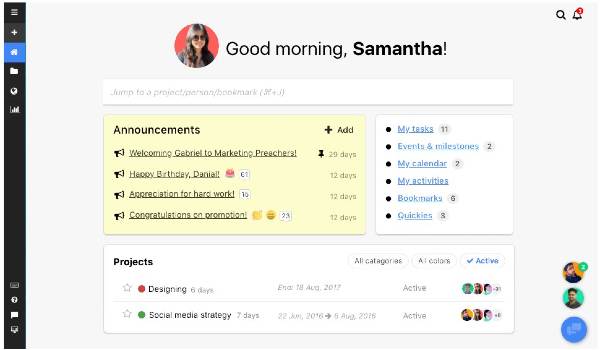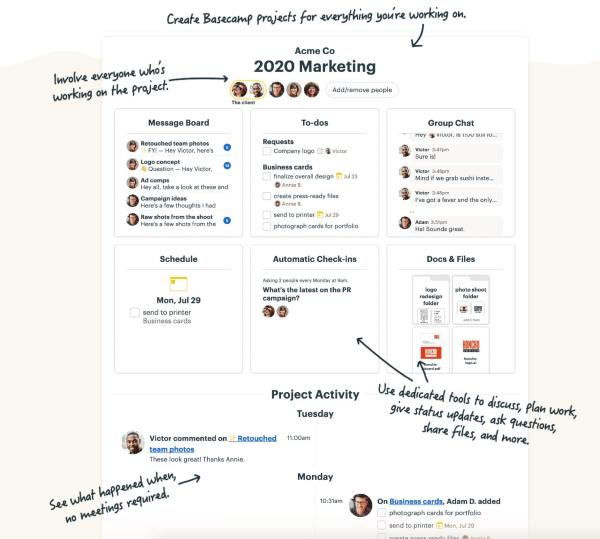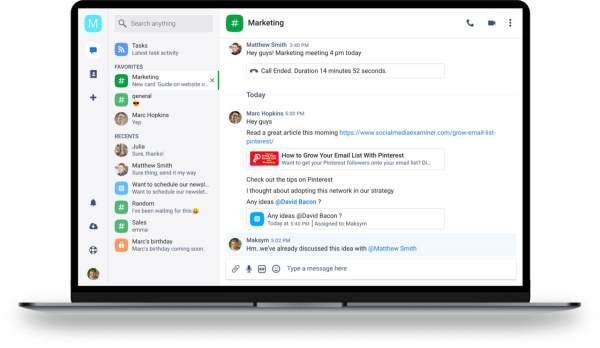Running a small business is hard. Any entrepreneur who’s bootstrapped their own startup is already familiar with all the struggles that one encounters during the earliest phases of company growth including project management.
As if all that wasn’t challenging enough, more obstacles have been added due to the global health issues that have plagued our planet in this new decade. If business owners hope to ride out the pandemic, then they’ll need to adapt to a remote working arrangement.
While this shift will no doubt be tricky, there are a few software solutions that can ease the transition. This article will focus on the value that each platform can bring to your business and the problems that it can solve.
#1 ProofHub
 ProofHub is one of the most popular project management solutions currently on the market due to its sheer versatility. While the flat pricing may not be ideal for smaller teams with five members or less, it’s absolutely perfect for larger businesses that need capacity at a low cost.
ProofHub is one of the most popular project management solutions currently on the market due to its sheer versatility. While the flat pricing may not be ideal for smaller teams with five members or less, it’s absolutely perfect for larger businesses that need capacity at a low cost.
While you’d be paying hundreds of dollars for other project managers just to get your entire market team on the platform, all you have to do is pay the fixed price for a ProofHub subscription then add as many users as you want.
Pricing starts at $50/month for the essential plan, while the ultimate control tier will run you $99/month. You can even save 10% on your subscription if you bill annually. If you have 100 team members and go for ultimate control, then you’re only paying $0.99/month for each user.
Some of the key problems that ProofHub helps with include task management, time tracking, file sharing, and document revision. You’ll also get 15 GB to 100 GB of storage depending on the plan that you go for — with Drive and Dropbox integrations providing an easy expansion path.
#2 Basecamp
 Basecamp is one of the oldest project management solutions that have not only remained relevant but even managed to retain its spot as a top choice. Since launching the software in 2004, its userbase has grown from 45 people to over three million. Not too shabby for 16 years.
Basecamp is one of the oldest project management solutions that have not only remained relevant but even managed to retain its spot as a top choice. Since launching the software in 2004, its userbase has grown from 45 people to over three million. Not too shabby for 16 years.
The developers pioneered the flat pricing system that ProofHub and some other alternatives use as their main selling point. The Basecamp Business plan costs a flat $99/month with unlimited user capacity, access to every feature on the platform, and 500 GB storage space.
Startups or small business owners who are trying to get their team collaboration under control without breaking the bank will love the Basecamp Personal plan as it’s totally free. You’ll still be able to add 20 users and even get a gigabyte of storage.
Some of the base benefits that Basecamp can bring to your business includes real-time chat, to-do lists, convenient scheduling, and file sharing. Lastly, with the sheer amount of storage space, you can save some money by canceling your other cloud storage subscriptions.
Convinced? You’ll be glad to know that you can get 15% off if you pay for a year upfront!
#3 Chanty
 Those who prefer text chat over video conferencing should consider using Chanty. Whether it’s sending links to collaborators, submitting files, or sharing your screen with the rest of the team, Chanty can turn communication into a seamless experience.
Those who prefer text chat over video conferencing should consider using Chanty. Whether it’s sending links to collaborators, submitting files, or sharing your screen with the rest of the team, Chanty can turn communication into a seamless experience.
The platform also has some project management capabilities that should cover the needs of most companies. You can assign tasks to any user on your team then navigate to the Teambook to see everything going on from a single place.
You can also pin messages to make it easier to review them later on. This ensures everyone stays on the same page and retains the core details even weeks into a particular project rather than gradually forgetting the initial information they got.
SMBs can use the free plan for as long as they want to. If you decide to upgrade, it’ll only run you $3/month for each user added to the subscription. This makes it very affordable for companies of all sizes while providing great value for the already minimal cost.
#4 Monday
 Let us start by saying that larger teams will probably be better off going for ProofHub or Basecamp as Monday’s per-user cost does add up quite fast. Even for teams of only 25 users, you’ll be paying over $150/month — on the cheapest plan at that!
Let us start by saying that larger teams will probably be better off going for ProofHub or Basecamp as Monday’s per-user cost does add up quite fast. Even for teams of only 25 users, you’ll be paying over $150/month — on the cheapest plan at that!
Sure, you could reduce that by 18% by billing annually, but $125/month isn’t much cheaper. That being said, smaller teams may end up paying less for Monday than they would for flatly-priced solutions. Scale plays a big part in the cost-value analysis of Monday for your business.
Much like the first two options covered in this article, Monday provides storage to ease file sharing and archiving. The exact capacity can vary widely from 5 GB to 1000 GB depending on the plan that you choose.
Features like the Kanban view, time tracking, and whiteboard collaboration streamline the workflow for everyone on your team. The wide selection of integrations includes apps like Zoom, Slack, Salesforce, Zendesk, Dropbox, Typeform, Excel, and more.
#5 Trello
 If the three-figure price tags and mile-long feature lists of the options above seem excessive for your business needs, then you may want to check out Trello. Over the past decade, it has become the gold standard for standalone Kanban software and is used by millions.
If the three-figure price tags and mile-long feature lists of the options above seem excessive for your business needs, then you may want to check out Trello. Over the past decade, it has become the gold standard for standalone Kanban software and is used by millions.
25 million users and counting to be exact. Simplicity and ease of use are two reasons why the tool has remained so popular despite multiple competitors entering the market since its launch in 2011.
The free plan of Trello has no time limit and lets you add unlimited cards. Team boards have a cap of 10 that can only be lifted by upgrading to a paid subscription, which shouldn’t be a problem if you don’t go crazy with splitting boards.
Companies with modest task management needs that just want a Kanban system to help them track ongoing project workflows will like the cost-effective and intuitive solution that is Trello. Those who upgrade to the business plan will pay $10/month for each user.
#6 Venngage
 With so many infographic makers available, it can be hard for companies to find the right one for them. Venngage makes a strong case because it has over a hundred templates, supports remote collaboration, and is already used by 21,000 businesses.
With so many infographic makers available, it can be hard for companies to find the right one for them. Venngage makes a strong case because it has over a hundred templates, supports remote collaboration, and is already used by 21,000 businesses.
This includes the likes of Google, Microsoft, Forbes, WIRED, and Harvard. While Venngage’s cheapest plan comes in at $19/month, it’s more targeted towards individuals rather than teams. We’d recommend you go for the business plan instead.
It offers an unlimited number of infographics, export in various formats, and full access to the platform’s collaboration functionality. While $49/month for each user isn’t exactly affordable to all businesses, the value Venngage brings makes up for the premium pricing.
Entrepreneurs with an internal graphic design team will be able to smoothen every step of the process from conceptualization to production and even revision. Every angle of collaborative design will be easier when you use Venngage.
#7 Google Docs
 While we’re on the topic of revisions, we might as well start covering the software used to write this very article. Everyone knows that Google Docs is the pinnacle of word processor technology.
While we’re on the topic of revisions, we might as well start covering the software used to write this very article. Everyone knows that Google Docs is the pinnacle of word processor technology.
In fact, Google Drive’s meteoric rise to a billion users is heavily attributed to the ubiquitous usage of Docs. While the biggest selling point of Docs is undoubtedly the seamless, reliable user experience, its flexibility also adds to the appeal.
You can express a unique company style with hundreds of fonts, versatile formatting options, and other styling tools that come with Google Docs. Companies with a G Suite subscription will even be able to access extra team control features when editing with Docs.
This is usually the part where we’d cover the pricing details, but Google Docs is totally free. This stands in stark contrast to Microsoft 365, which, at its cheapest, costs $6.99/month for each user. While you could buy Word on its own, it’ll cost you a ludicrous $140!
#8 Time Doctor
 Upon switching your workforce to a remote arrangement, you’ll likely find that tracking billable hours is no longer as easy as having employees punch in when they arrive at the office. While some project management platforms have time trackers, not all of them are sufficient.
Upon switching your workforce to a remote arrangement, you’ll likely find that tracking billable hours is no longer as easy as having employees punch in when they arrive at the office. While some project management platforms have time trackers, not all of them are sufficient.
If your company is in a position where it needs a standalone tracker, then you may want to check out Time Doctor. It can help you track breaks, see which apps your employees use most, and monitor the big picture through its reporting infrastructure.
This level of tracking ensures that you don’t accidentally overpay employees for time they didn’t spend working and can even make it easier to identify time sinks. If you notice that a specific non-essential app has employees wasting a lot of time, then you can block it.
Time Doctor helps you optimize employee productivity by eliminating distractions. Faster project turnarounds, fewer missed deadlines, and reduced company overhead costs are just a few benefits that you can reap by using the solution for only $7/month.
#9 GoToMeeting
 Next up, a collaboration essential: video conferencing software. When working remotely, you’ll need a robust solution like GoToMeeting to make it easy for employees to set up a virtual office where they can exchange ideas and work together on crucial projects.
Next up, a collaboration essential: video conferencing software. When working remotely, you’ll need a robust solution like GoToMeeting to make it easy for employees to set up a virtual office where they can exchange ideas and work together on crucial projects.
Convenience is a big reason why so many people have become a fan of the platform. You can launch meetings with a single click through Slack, Chrome, Google Calendar, Microsoft 365, and Outlook.
GoToMeeting supports both recordings and transcription, meaning reviewing your past meetings will be a breeze with the software. It’s even HIPAA-ready, which makes it perfect for companies in the medical industry.
The professional plan costs $14/month and can handle up to 150 participants. You can even shave another $2/month off the price by billing annually, which makes the subscription very affordable for businesses of all sizes.
#10 Fleep
 Finally, to close off the list, one last messaging solution. Fleep may not be as widely used as Slack, but there are some differences that may make the switch worthwhile for your business. For instance, a few users have said that the native task management beats Slack in usability.
Finally, to close off the list, one last messaging solution. Fleep may not be as widely used as Slack, but there are some differences that may make the switch worthwhile for your business. For instance, a few users have said that the native task management beats Slack in usability.
Fleep also takes a unique approach to presence tracking. Rather than relying solely on an online/offline system, it shows you when they were last active on the app, marks messages as read once they see it, and uses a typing indicator to improve the flow of conversation.
One of the biggest benefits of using Fleep is the fact that it can be used with countless integrations. This includes Trello, Zapier, Slack, Drive, Dropbox, GitLab, and more. If you need a team communication solution centered on synergy, then Fleep is for you.
The basic plan is free to use, gives you 10 GB of storage, and doesn’t limit your message history as some other platforms do. The business tier costs $6/month for each user but expands your storage tenfold, unblocks custom branding, and removes limitations on group convos.
Conclusion
As you can see, there are countless collaboration tools within arms reach that you can use to take your company’s remote workflow to the next level. With the rapidly changing landscape of business, “adapt to survive” is the name of the game — and software is like evolution points.
Use these evolution points to turn your company into the ultimate apex predator, finely tuned for the next frontier of business. If you think we missed any great collaboration tools, then be sure to share this post on social media and list your favorites.
That’s all for now, stay safe, and happy collaborating!
Jake Lizarraga is a content writer who reviews software for Chanty – powerful and free Slack alternative. The combination of humor and conciseness makes every piece of his a fun read. When he isn’t writing, Jake loves watching movies, practicing Muay Thai, and geeking out about the fact that Melissa Benoist now speaks Russian on CW’s Supergirl.
Collaboration/Project Management stock photo by EtiAmmos/Shutterstock







